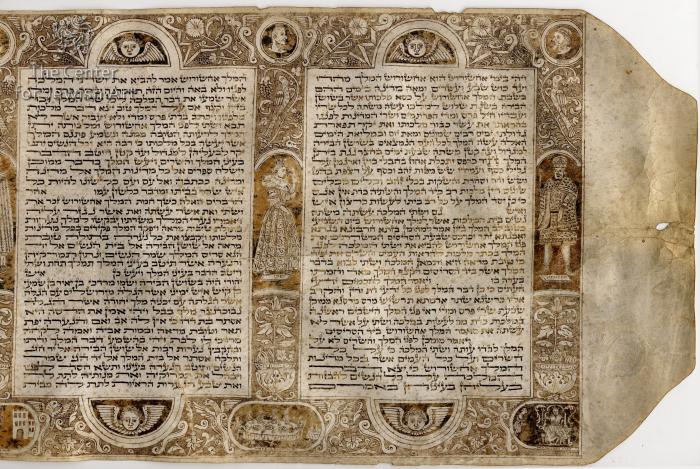Obj. ID: 36685
Hebrew Illuminated Manuscripts JMP Aryeh Leib ben Daniel of Goray Sepia Esther Scroll, Italy (?), 1740s

This lavishly decorated scroll is not signed but its ornamentation resembles the style of the megillot Esther executed by the scribe-artist Aryeh Leib son of Daniel of Goray (Pol. Goraj), Poland. The right edge of the first membrane is trimmed. The upper margins adorn angel’s heads framed in semicircles placed at the center of each text panel. They are flanked by flowers and bunches of grapes. Every section is alternated with medallions containing the busts of the minor characters of the Esther story who are identified by their names written in a semi-cursive Hebrew script; they are Mehuman, Bizetha, Harbonah, Bigtha, Abaghta, Zethar, Carcas, Bigthan, Teresh, Hatakh, Hegai, Shaashgaz, and Memucan. The roundels are flanked by architectonic elements with winged busts. The text is inscribed in the rectangular panels interspersed by full-length figures of the main characters of the Esther story that appear in the niches; they are Ahasuerus, Vashti, Mordecai, Esther, Haman, Zeresh, Hatakh, Carshena, Shethar, Admatha, Tarshish, Meres, and Marsena. Also, these figures are identified by their names inscribed in the same type of Hebrew script as above. The spaces above them are adorned with birds sitting on twigs while below them there are decorative urns with plants and fruits. The lower margins embellish heads of angels framed in semicircles, the same as in the upper margins and they alternate with ovals containing narrative scenes reflecting the Purim story placed; the illustrations are placed below the vases. They are flanked by architectonic elements with birds and flowers (possibly daffodils) and are also captioned in semi-cursive Hebrew script. The background behind them is covered with a repeating composition including birds. Additionally, the hand-drawn imitation of the cross-hatching fills the background of all decorated spaces. The narrative cycle of this scroll includes an additional depiction incorporated into the 10th text column. The left margin of the last membrane is trimmed into a semicircle.
sub-set tree:
The manuscript is well preserved, although some parts of the text are lighter and less visible.
The scroll is formed of 4 sheets containing 12 columns of the text with 34 lines, except for col. 10 with 11 lines divided into two parts and col. 12 with 32 lines.
The number of text columns per sheet: no. 1 – 4, no. 2 – 3, no. 3 – 2, no. 4 - 3.
The text is inscribed in the Hebrew square script with tagim, in brown ink on the flesh side of the parchment membranes.
The letter ח (Es. 1:6) is enlarged and decorated with scrolled feet. The letter ת (Es. 9:29) is enlarged and bolded. Other enlarged and diminished letters are included in col. 10.
The letters of the Tetragrammaton are marked with a single taga that is bent to the right.
The ruling - horizontal and vertical lines - is made with a hardpoint.
The membranes in the scroll are stitched together.
None
The former number of the scroll is Ms 313.
Olga Sixtova, O svitku / Form of the Scroll [katalog k výstavě konané v Galerii Roberta Guttmanna Židovského muzea v Praze od 22. června do 26. července 2006], Praha 2006, 32-33.
https://collections.jewishmuseum.cz/index.php/Detail/Object/Show/object_id/221251 (accessed on 7.11.2020).
Bibliography on scrolls made by Aryeh Leib ben Daniel of Goray or attributed to him:
Dagmara Budzioch, The Decorated Esther Scrolls from the Museum of the Jewish Historical Institute in Warsaw and the Tradition of Megillot Esther Decoration in the Seventeenth and Eighteenth Centuries – An Outline [Polish: Dekorowane zwoje Estery z Żydowskiego Instytutu Historycznego w Warszawie na tle tradycji dekorowania megilot Ester w XVII i XVIII wieku. Zarys problematyki], Warsaw 2019, 1:206-215.
Victor Klagsbald, Catalogue raisonné de la collection juive du Musée de Cluny, Paris 1981, 64-66, object 73.
Mendel Metzger, The Earliest Engraved Italian Megilloth, Bulletin of the John Rylands Library 1966, 48/2, esp. 409, 422-425.
Ernest Namenyi, "The Illumination of Hebrew Manuscripts after the Invention of Printing," in Cecil Roth (ed.), Jewish Art, an Illustrated History (London, 1961), col. 435.
A Journey through Jewish Worlds: Highlights from the Braginsky Collection of Hebrew Manuscripts and Printed Books, eds. Evelyn M. Cohen, Emile Schrijver, Sharon Liberman Mintz, Amsterdam 2009, 246-249.
Schöne Seiten. Jüdische Schriftkultur aus der Braginsky Collection, eds. Emile Schrijver, Falk Wiesemann, Evelyn M. Cohen, Sharon Liberman Mintz, Menahem Schmeltzer, Zurich 2011, 266-269.
A Fine Illustrated Esther Scroll, [ca. 1740], lot 105, Sotheby's New York Important Judaica, 20 December 2017 https://www.sothebys.com/en/auctions/ecatalogue/lot.105.html/2017/important-judaica-n09687 (accessed on 31.07.2020).
A Magnificent Esther Scroll Written and illustrated Aryeh Leib ben Daniel of Goray, Schwelm, 1737, lot 187, Sotheby's New York Important Judaica Including Property from the Estate of Shlomo Moussaieff, 15 December 2016 https://www.sothebys.com/en/auctions/ecatalogue/2016/important-judaica-n09589/lot.187.html (accessed on 31.07.2020).







